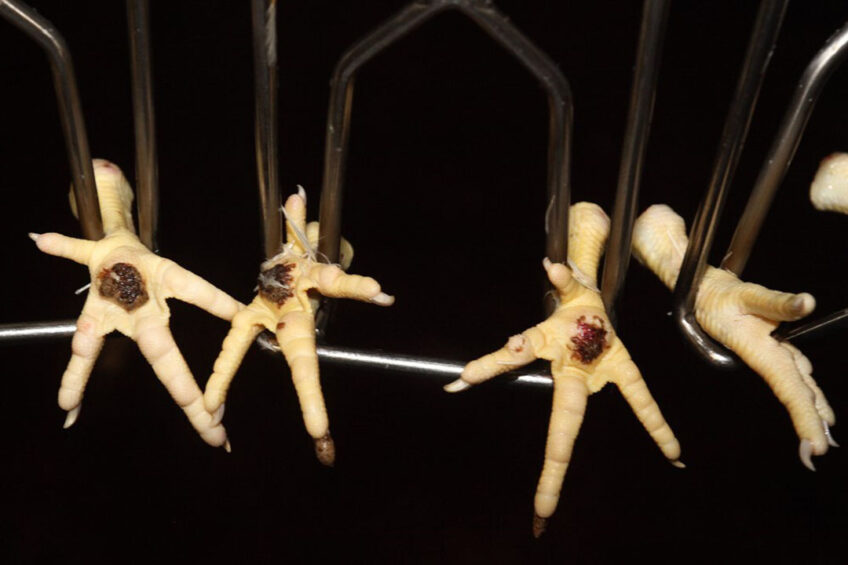Footpad dermatitis in broilers influenced by orange corn

Although there are many predisposing factors of footpad dermatitis in poultry, a team of researchers in the US set out to determine the effect of orange corn diets on this condition.
Footpad dermatitis can be seen in various types of broiler production systems with varying degrees of severity. This condition has an impact on bird welfare and production value and can result in chicken paw downgrades, carcass condemnations, and reduced live weights.
Predisposing factors
Many predisposing factors of footpad dermatitis have been identified, including litter quality, litter depth, water drinker type, bird age, and bioavailability of biotin in the diet. Yet, one of the most significant contributing factors is the presence of wet litter.
Carotenoids
Carotenoids may be part of a solution having shown to have protective effects in birds and are believed to play a role in skin and feather health. Carotenoids, which cannot be synthesized and must be consumed via the diet, are a group of natural pigments responsible for the yellow, orange, and red colouration of fruit, flowers, and vegetables. Orange corn contains carotenoid levels of about 40-60 μg/g, whereas conventional yellow corn averages about 10-20 μg/g.
A team of researchers* in the US, therefore, hypothesised that diets containing orange corn, when compared with diets containing yellow or white corn, would reduce the severity of footpad dermatitis in broiler chickens on wet litter.
A study of yellow, white and orange corn in broilers
Female Ross 708 chickens (N = 960, 40 birds per pen) were placed in 3.71 m2 pens on litter of fresh pine wood shavings at a stocking density of 0.08 m2/bird at 1 day of age and followed up through 42 days of age.
The birds were raised on 1 of 2 litter treatments – dry (control) or wet litter (60% moisture content) – and fed 1 of the following 3 diets, either orange corn, yellow corn or white corn. Each diet × litter treatment combination was replicated 4 times.
Footpad scoring
Footpads were scored at day 19, 27, 35, and 42 following the Global Animal Partnership standards. A score of 0 was considered ideal and represented minimal to no damage to the foot. A score of 1 and 2 indicate mild to severe lesions and ulceration, dark papillae, and/or bumble foot, which is considered footpad dermatitis.
Results
At 42 days of age, birds on the wet litter had greater severity of footpad dermatitis, scores 1 and 2, compared with the control group (88% vs. 13%, respectively). At 42 days of age, the prevalence of more severe footpad scores, 1 or 2, was lowest on the orange corn diet (33%), followed by white corn (56%) and yellow corn (63%). Birds fed the orange corn diet had higher bodyweight throughout the study and had fat pads and livers with higher yellow pigment deposition.
Best nutrition for footpad health
Correct concentrations of vitamins and minerals and good management practices are needed, particularly for free-range birds, in order to avoid footpad dermatitis (FPD). Read more…
As the birds grew, both white and yellow corn groups had increasing incidence of moderate and severe footpad scores on wet litter. The orange corn group on wet litter saw a peak of moderate footpad scores at 27 days of age which then declined until termination of the study. The orange corn diet had the longest absence of severe footpad scores, the wet litter group fed yellow and white corn had severe footpad scores by 27 days of age, while birds fed the orange corn did not develop severe scores until 35 d of age. All 3 corn groups saw increasing severe footpad scores between day 35 and 42 with the largest increase occurring in the white corn group followed by the yellow and orange corn groups, respectively.
Proportions of broiler footpad scores throughout the 42-day study.

An unexpected benefit of orange corn
The orange corn diet was that it increased the birds’ average BW throughout this study, likely due to differences in nutritional content between the different corn types. Orange corn source had the highest levels of ME, CP, and crude fat. This increased nutritional content likely contributed to the birds’ increased weight gain and growth. The elevated weight gains in this study did not, however, translate into improved FCR. Overall feed conversion rate was unaffected by diet and litter treatment.
Chinese demand for chicken paws
The chicken paw market is a significant one – in just the first 5 months of 2021, paw exports from the US to China totalled just over 105,000 mt with a total value of nearly US$ 254 million. Read more…
In addition to improving the weight gain of the birds in this study, the orange corn diets were associated with increased pigment deposition in the liver and fat pad.
Conclusions
The main determinant of footpad dermatitis was exposure to wet litter. When compared with yellow and white corn, orange corn was associated with improved bird growth and reduced severity of footpad dermatitis, especially at the later stages of the study.
*M. E. Abraham, K. Scoles, J. I. Vargas, T. A. Johnson, D. M. Karcher (Department of Animal Sciences, Purdue University), L. Hoverman, E. Rocheford, T. Rocheford (NutraMaize), C. Robison (Department of Animal Sciences, Michigan State University), D. Ortiz, T. Rocheford (Department of Agronomy, Purdue University) and S. L. Weimer (Department of Animal and Avian Sciences, University of Maryland).













